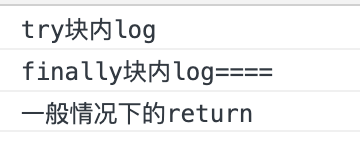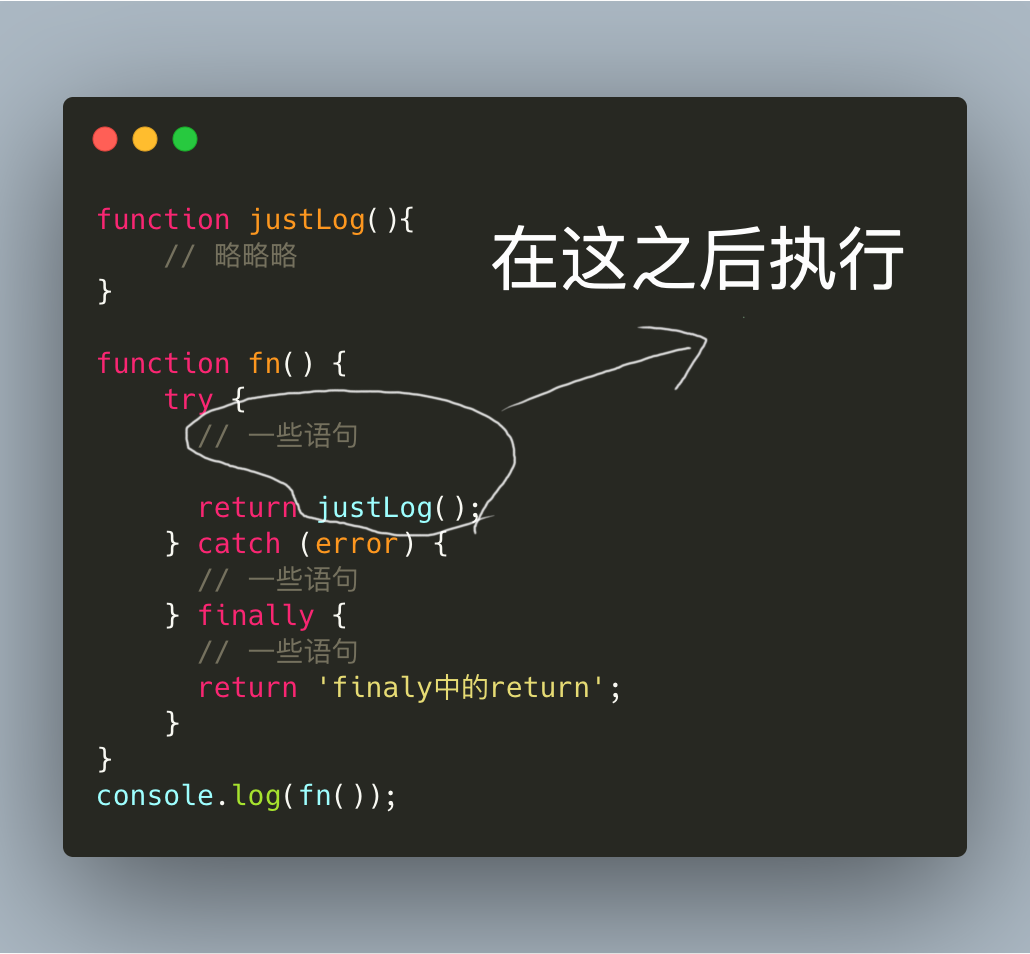首先来看下 MDN 的定义:
The try...catch statement marks a block of statements to try and specifies a response should an exception be thrown.
try...catch语句标记要执行的语句,并指定一个当有异常抛出时候的响应
简短的一句的确描述了try...catch的大部分功能。
但是,最MDN的最后,有一段话是这么写的:
Returning from a finally-block
If the finally-block returns a value, this value becomes the return value of the entire try-catch-finally statement, regardless of any return statements in the try and catch-blocks. This includes exceptions thrown inside of the catch-block:
finally语句块的返回值
如果finally语句块中有返回值,那么这个值将作为整个try...catch语句的返回,无论try语句块或者catch语句块中是否有返回,这包括了catch中的异常。
ok,那我们就尝试加上return,看看会发生什么。
function fn() {
try {
console.log('try块内log');
} catch (error) {
console.log('catch块内log');
} finally {
console.log('finally块内log====');
}
return '一般情况下的return';
}
console.log(fn());
一切看起来都如我们所想,没有问题,继续往下看。
function fn() {
try {
console.log('try块内log');
return 'try中的return'; // <=== 多了这么一句
} catch (error) {
console.log('catch块内log');
return 'catch中的return语句';
} finally {
console.log('finally块内log====');
}
return '一般情况下的return';
}
console.log(fn());
正如上图所示,这里打印的是try的return,但是,finally语句块中的log依然被执行了。
看到这里,我们可以知道,finally的执行时机是在try(或者cache,cache同理)执行return之前被执行。
那我们就可以验证下MDN上所说的:finally语句块的返回值 这句话的真正含义。
function fn() {
try {
console.log('try块内log');
return 'try中的return'
} catch (error) {
console.log('catch块内log');
return 'catch中的return语句';
} finally {
console.log('finally块内log====');
return 'finaly中的return'; // <=== 多了这么一句
}
return '一般情况下的return';
}
console.log(fn());
ok,依然很正常,因为finally会在try的return之前执行,所以拦截了try中的return,打印了finally中的return。
你以为这样就结束了吗?
我们继续往下看。
function justLog(){
console.log('来自justLog的打印');
return '来自justLog的return'
}
function fn() {
try {
console.log('try块内log');
return justLog(); // <=== 这次我们return了一个函数
} catch (error) {
console.log('catch块内log');
return 'catch中的return语句';
} finally {
console.log('finally块内log====');
return 'finaly中的return';
}
return '一般情况下的return';
}
console.log(fn());先思考一下会打印什么?看看是否和真实的输出一致。给我们几秒钟...
小小的声援一下,希望战‘役‘早日胜利。加油!
然后:
我会长期更新有趣的,有料的前端知识,如果对你有帮忙,请关注我,日后接受第一手更新消息。非常感谢


你答对了没有?
可以看到,红框内为justLog函数的log,红框下面是finally中的打印和返回。
所以finally真正的执行时机是:try(或catch)中 return关键字之前。
所以我们才看到了justLog中的打印。
有关return关键字的实现,可以自行查询标准,这里不赘述。
比如我们有这样一个高阶函数:
function hoc(fn) {
return fn()
}我们想要返回所传递参数的执行结果,这样做是没问题的。
那如果我们想在函数执行之后,return之前,做一些其他操作,应该怎么做呢?
function hoc(fn) {
const res = fn();
// 其他操作
return res;
}很简答,我们可以先获取返回值,再进行其他操作,然后return。
不过这样我们就占用了额外的空间,而且无法便利的复用return后的语句,这个时候,我们的try...catch就可以排上用场了:
function hoc(fn) {
try {
return fn();
} finally {
// 一些其他操作,这些操作会在 `fn()执行后,return执行前` 被执行
}
}大白话来讲,finally语句块会在try(或catch)中的 return 关键字之前执行。一图以概之:

最后,如果有帮到你的地方,欢迎关注、交流。
再问你一遍,你真的了解try..catch(finally)吗???
原文:https://www.cnblogs.com/xiaoyuxy/p/12297701.html